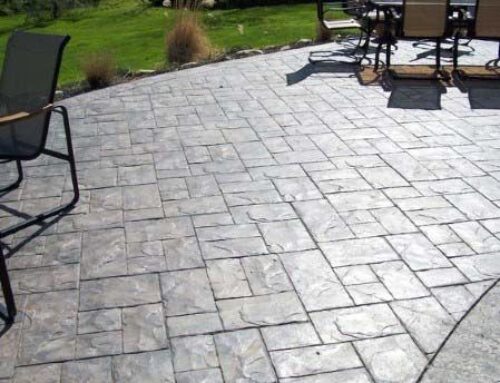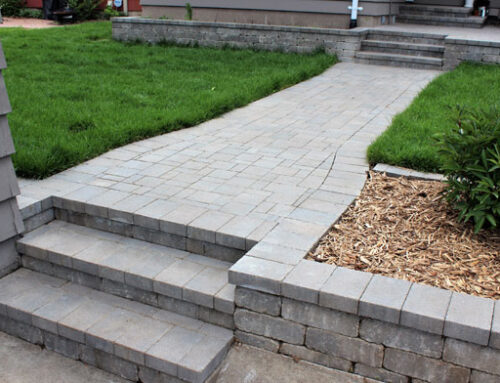Could your home’s curb appeal use a little boost? If so, then it might be time to install a new walkway. Whether you’re looking to create a more inviting entrance to your home or simply want to add some visual interest to your landscaping, a well-designed and installed walkway can make all the difference.
Of course, before you can enjoy your newly installed walkway, you’ll need to put in a bit of work (or hire someone who can). From choosing the right materials to preparing the ground and ensuring proper drainage, there’s a lot that goes into installing a walkway. But don’t worry, we’re here to help.
In this guide, we’ll cover everything you need to know about walkway installation, including:
– Choosing the right materials for your walkway
– Designing your walkway
– Preparing the ground for installation
– Installing the walkway
– Caring for your new walkway.
By the time you’re finished reading, you’ll have all the information you need to install a beautiful, functional walkway of your own. So let’s get started!
Choosing the Right Materials for Your Walkway
When it comes to choosing materials for your walkway, you have a lot of options. From traditional paving stones to more modern concrete pavers, there’s no shortage of choices on the market today. Of course, it can be hard to know where to start with so many options available.
Here are a few things to keep in mind as you choose materials for your walkway:
– Budget: Perhaps the most important factor to consider when choosing materials for your walkway is your budget. Walkway installation can be a fairly costly project, so it’s important to choose materials that fit within your price range
– Location: Another important consideration is where your walkway will be located. If you’re installing a walkway that will be exposed to the elements, you’ll need to choose materials that can withstand harsh weather conditions. Conversely, if your walkway is located in a protected area, you’ll have more leeway in material choice.
– Aesthetics: Of course, you’ll also want to choose materials that complement the overall look and feel of your home. If you have a traditional home, for example, you might want to choose more classic paving materials like brick or stone. If your home has a more modern aesthetic, however, you might opt for concrete pavers or other contemporary materials.
Designing Your Walkway
Once you’ve chosen the right materials for your walkway, it’s time to start thinking about design. When designing your walkway, there are a few key things to keep in mind:
– Function: First and foremost, your walkway should be functional. It should be wide enough to accommodate foot traffic and provide a clear path from one point to another.
– Aesthetics: Of course, you’ll also want your walkway to be attractive. When designing your walkway, consider the overall look and feel of your home and choose a design that complements its style.
– Materials: The materials you’ve chosen for your walkway will also play a role in its design. For example, if you’re using paving stones, you’ll need to account for the space needed between each stone as you design your walkway.
– Drainage: Finally, be sure to take drainage into consideration when designing your walkway. If your walkway is located in an area that gets a lot of rainfall, you’ll need to make sure it slopes slightly so that water can drain off the sides.
Preparing the Ground for Installation
Once you’ve designed your walkway, it’s time to start preparing the ground for installation. This is a fairly simple process if you’re doing the work yourself. First, clear the area where your walkway will be located of any debris or vegetation. Next, use a garden hose or string to mark out the perimeter of your walkway. Finally, excavate the area inside the perimeter to a depth of about four inches.
If you’re hiring someone to install your walkway, they’ll likely take care of all the ground preparation for you. However, it’s still a good idea to clear the area and mark out the perimeter before they begin work. This will help ensure that your walkway is installed exactly as you envisioned it.
Installing Your Walkway
Now it’s time for the fun part: installing your walkway! This process will vary depending on your chosen materials for your project. Here are a few tips to keep in mind as you install your walkway:
– If you’re using paving stones, be sure to compact the ground before you begin laying them. This will help ensure that your walkway is level and even.
– When installing pavers, it’s important to start at one end and work your way towards the other. This will help you avoid any gaps or uneven spots in your walkway.
– Be sure to use a level when installing pavers or concrete slabs to ensure that they’re even with the ground. Uneven pavers can create trip hazards and make your walkway look unsightly.
– If you’re using concrete, be sure to smooth it out with a trowel as you pour it into place. This will help ensure a level surface for your walkway.
– Once the concrete has been set, you can use a power washer to remove any imperfections from the surface.
Finishing Touches
Once your walkway is installed, it’s time to add the finishing touches! If you’re using paving stones, you may want to add gravel or sand between the stones to fill in any gaps. You can also use edging materials like brick or stone pavers to create a border around your walkway. Finally, be sure to sweep or power wash your walkway regularly to keep it looking its best.
There are a few things to keep in mind when it comes to walkway installation. But with careful planning and execution, you can create a beautiful and functional walkway that will add value to your home.





